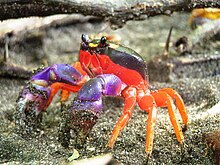This is an old revision of this page, as edited by Cgalindo (talk | contribs) at 04:27, 15 July 2021 (→Behaviour). The present address (URL) is a permanent link to this revision, which may differ significantly from the current revision.
Revision as of 04:27, 15 July 2021 by Cgalindo (talk | contribs) (→Behaviour)(diff) ← Previous revision | Latest revision (diff) | Newer revision → (diff) Species of crab "Halloween crab" and "Halloween moon crab" redirect here. For the species of hermit crab, see Halloween hermit crab.
| Gecarcinus quadratus | |
|---|---|

| |
| On Parida Island, Panama | |
| Scientific classification | |
| Domain: | Eukaryota |
| Kingdom: | Animalia |
| Phylum: | Arthropoda |
| Class: | Malacostraca |
| Order: | Decapoda |
| Suborder: | Pleocyemata |
| Infraorder: | Brachyura |
| Family: | Gecarcinidae |
| Genus: | Gecarcinus |
| Species: | G. quadratus |
| Binomial name | |
| Gecarcinus quadratus De Saussure, 1853 | |
Gecarcinus quadratus, known as the red land crab, whitespot crab, Halloween crab, moon crab, Halloween moon crab, mouthless crab or harlequin land crab, is a colourful land crab from the family Gecarcinidae.
Distribution
Gecarcinus quadratus is found in mangrove, sand dunes and rainforest along the Pacific coast from Mexico south to Panama. Previously it has also been reported from the Pacific coast of northwestern South America, but in 2014 this population was recognized as a separate species, G. nobili.
The taxonomy in relation to the Atlantic G. lateralis is disputed, with many considering G. quadratus and G. lateralis to be conspecific.
Description

The carapace of G. quadratus may reach a length of 5 centimetres (2.0 in). It has a pair of largely purple claws, red-orange legs, and an almost entirely black carapace with a pair of yellow, orange or reddish spots behind the eyes, and an additional pair of whitish spots on the central-lower carapace.
Behaviour
This nocturnal crab digs burrows – sometimes as long as 1.5 metres (4.9 ft) – in the coastal rainforests of México, Central America, and is common along the coasts of México, Costa Rica, Panama, and Nicaragua. It lives in the forest at least some of its adult life, but needs to return to the ocean to breed. It is largely herbivorous, and consumes leaf litter and seedlings.
References
- ^ Donald B. Bright & Charles L. Hogue (1972). "A synopsis of burrowing land crabs of the World and list of their arthropod symbionts and burrow associates" (PDF). Contributions in Science. 220. Archived from the original (PDF) on 2010-10-09.
- ^ T. Beth Kinsey. "Halloween Crab". The Firefly Forest. Retrieved July 28, 2011.
- ^ Lawrence G. Abele, Michael H. Robinson & Barbara Robinson (1973). "Observations on sound productions by two species of crabs from Panama (Decapoda, Gecarcinidae and Pseudothelphusidae)" (PDF). Crustaceana. 25 (2): 147–152. doi:10.1163/156854073X00795.
- ^ Robert Perger & Adam Wall (2014). "The description of a new species of the Neotropical land crab genus Gecarcinus Leach, 1814 (Crustacea, Decapoda, Brachyura, Gecarcinidae)". ZooKeys (435): 93–109. doi:10.3897/zookeys.435.7271. PMC 4141188. PMID 25152688.
{{cite journal}}: CS1 maint: unflagged free DOI (link) - ^ Peter M. Sherman (2006). "Influence of land crabs Gecarcinus quadratus (Gecarcinidae) on distributions of organic carbon and roots in a Costa Rican rain forest" (PDF). Revista de Biología Tropical. 54 (1): 149–161. PMID 18457184.
External links
- [REDACTED] Media related to Gecarcinus quadratus at Wikimedia Commons
| Extant Gecarcinidae species | ||
|---|---|---|
| Cardisoma | 
 | |
| Discoplax | ||
| Epigrapsus | ||
| Gecarcinus | ||
| Gecarcoidea | ||
| Johngarthia | ||
| Tuerkayana | ||
| Taxon identifiers | |
|---|---|
| Gecarcinus quadratus | |